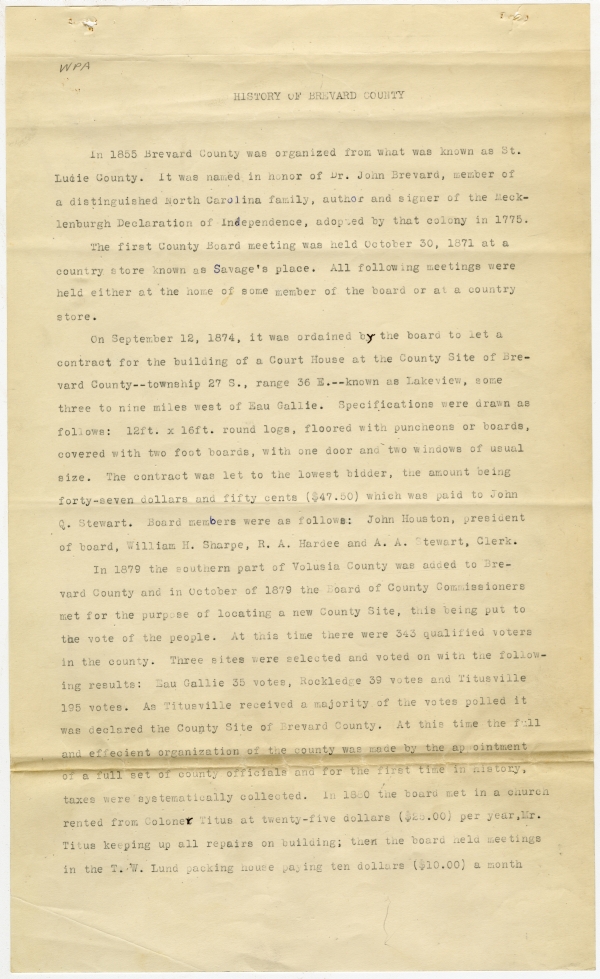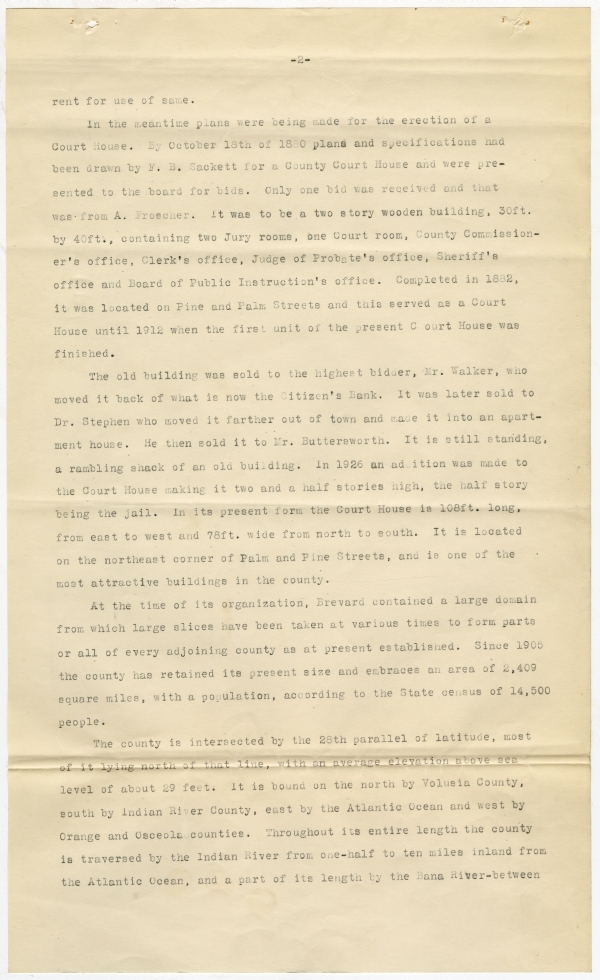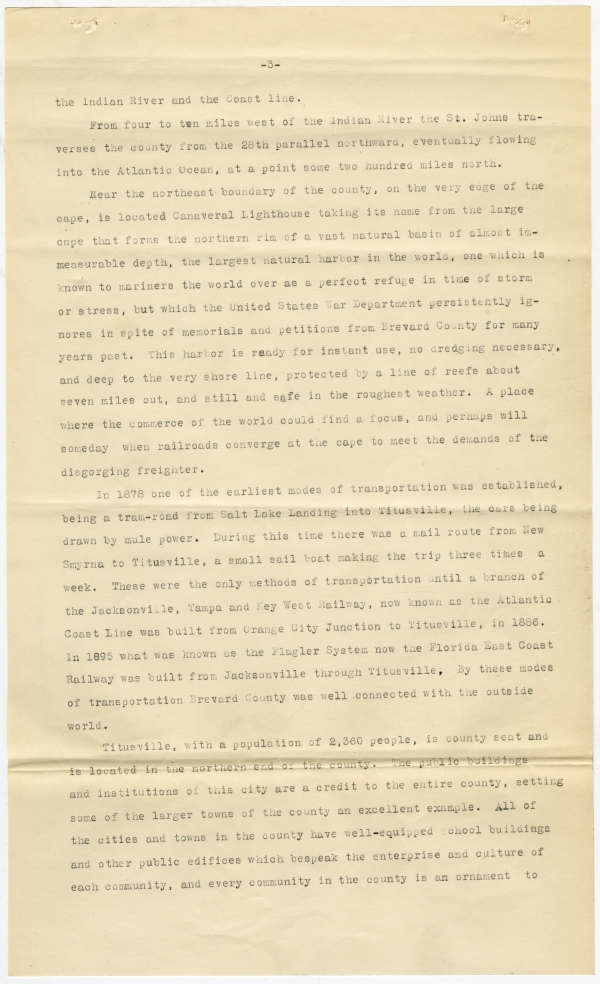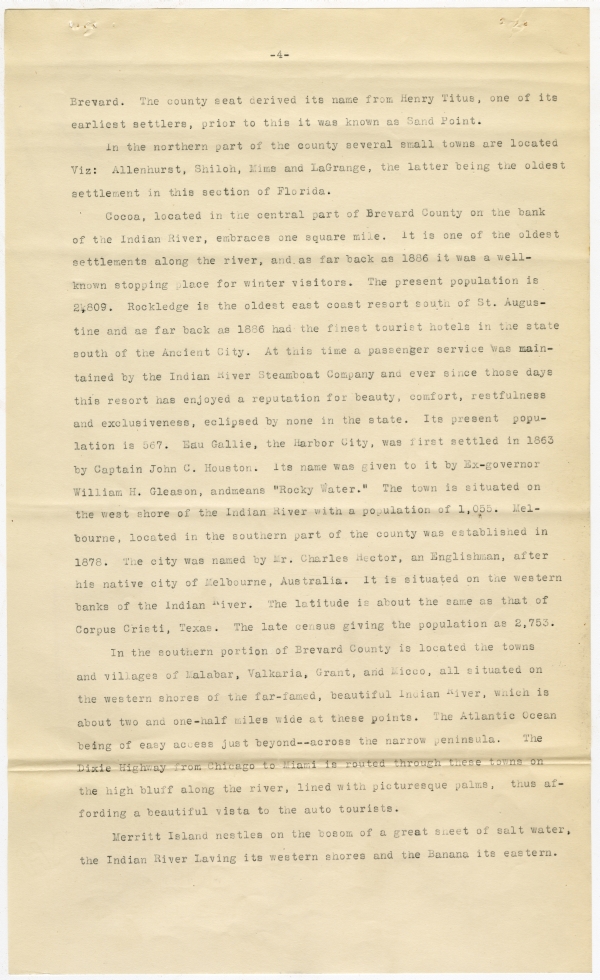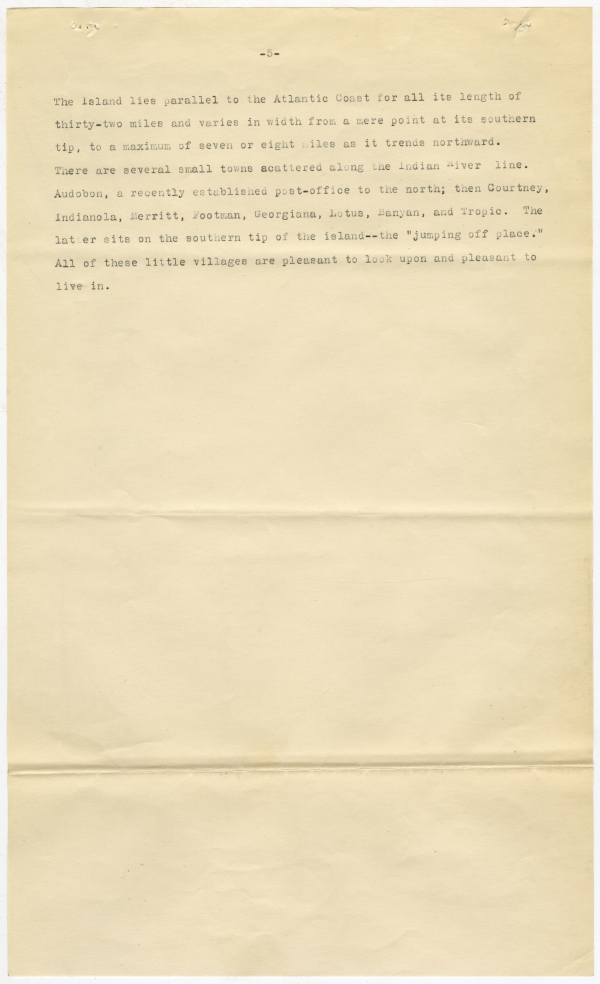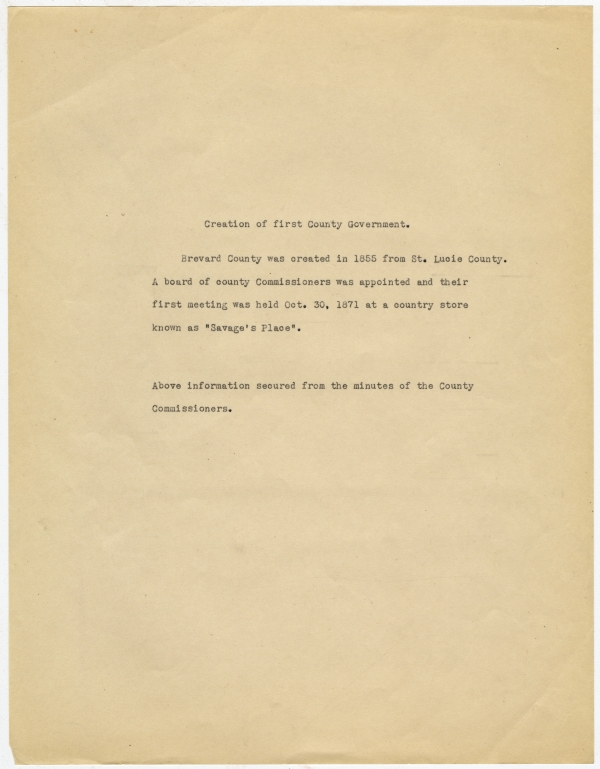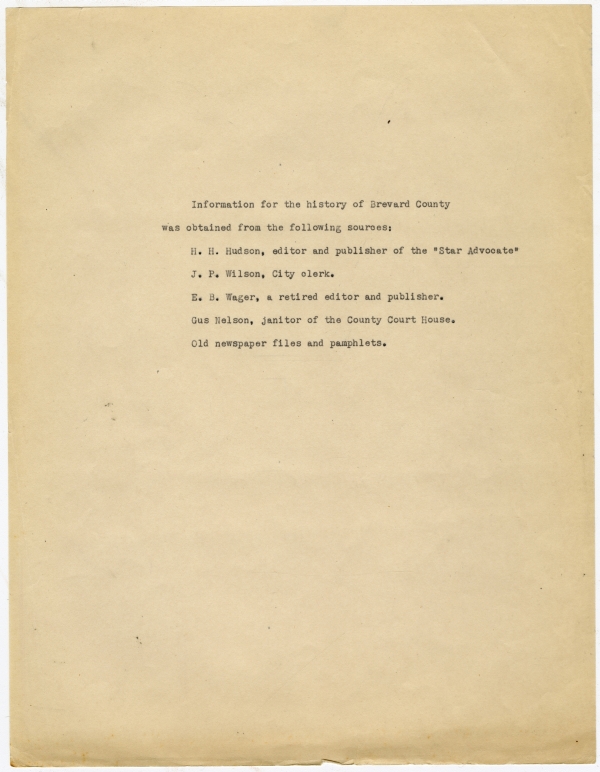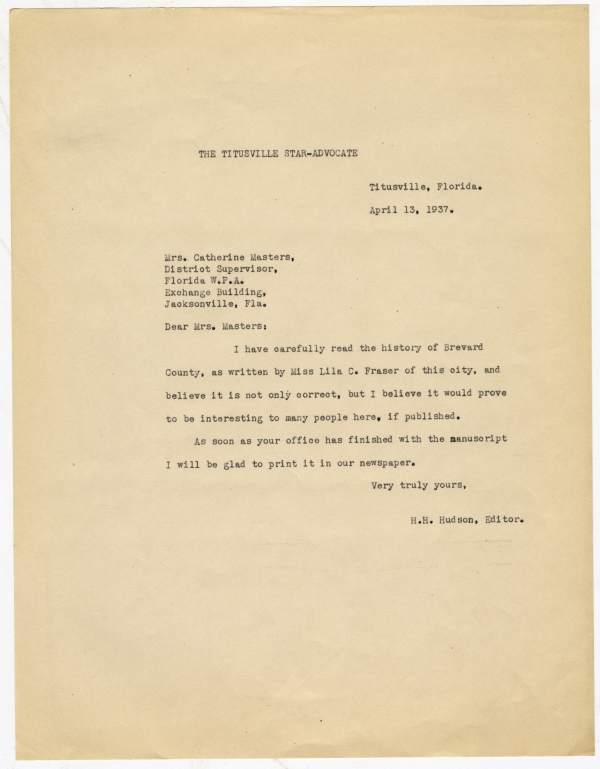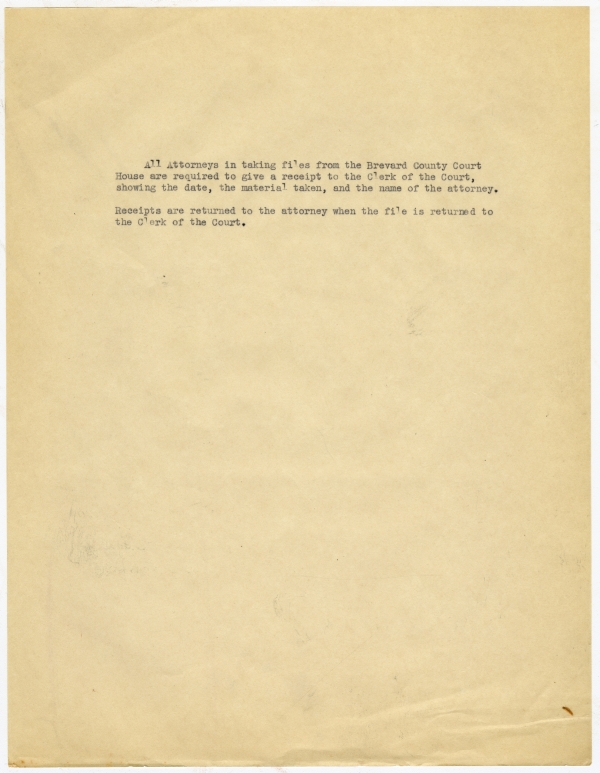Transcript
WPA
HISTORY OF BREVARD COUNTY
In 1855 Brevard County was organized from what was known as St. Lucie County. It was named in honor of Dr. John Brevard, member of a distinguished North Carolina family, author and signer of the Mecklenburgh Declaration of Independence, adopted by that colony in 1775.
The first County Board meeting was held October 30, 1871 at a country store known as Savage’s place. All following meetings were held either at the home of some member of the board or at a country store.
On September 12, 1874, it was ordained by the board to let a contract for the building of a Court House at the County Site of Brevard County—township 27 S., range 36 E.—known as Lakeview, some three to nine miles west of Eau Gallie. Specifications were drawn as follows: 12ft. x 16ft. round logs, floored with puncheons or boards, covered with two foot boards, with one door and two windows of usual size. The contract was let to the lowest bidder, the amount being forty-seven dollars and fifty cents ($47.50) which was paid to John Q. Stewart. Board members were as follows: John Houston, president of board, William H. Sharpe, R. A. Hardee and A. A. Stewart, Clerk.
In 1879 the southern part of Volusia County was added to Brevard County and in October of 1879 the Board of County Commissioners met for the purpose of locating a new County Site, this being put to the vote of the people. At this time there were 343 qualified voters in the county. Three sites were selected and voted on with the following results: Eau Gallie 35 votes, Rockledge 39 votes and Titusville 195 votes. As Titusville received a majority of the votes polled it was declared the County Site of Brevard County. At this time the full and efficient organization of the county was made by the appointment of a full set of county officials and for the first time in history, taxes were systematically collected. In 1880 the board met in a church rented from Coloner Titus at twenty-five dollars ($25.00) per year, Mr. Titus keeping up all repairs on building; then the board held meetings in the T. W. Lund packing house paying ten dollars ($10.00) a month
-2-
rent for use of same.
In the meantime plans were being made for the erection of a Court House. By October 18th of 1880 plans and specifications had been drawn by F. B. Sackett for a County Court House and were presented to the board for bids. Only one bid was received and that was from A. Froscher. It was to be a two story wooden building, 30ft. by 40ft., containing two Jury rooms, one Court room, County Commissioner’s office, Clerk’s office, Judge of Probate’s office, Sheriff’s office and Board of Public Instruction’s office. Completed in 1882, it was located on Pine and Palm Streets and this served as a Court House until 1912 when the first unit of the present Court House was finished.
The old building was sold to the highest bidder, Mr. Walker, who moved it back of what is now the Citizen’s Bank. It was later sold to Dr. Stephen who moved it farther out of town and made it into an apartment house. He then sold it to Mr. Buttersworth. It is still standing, a rambling shack of an old building. In 1926 an addition was made to the Court House making it two and a half stories high, the half story being the jail. In its present form the Court House is 108ft. long, from east to west and 78ft. wide from north to south. It is located on the northeast corner of Palm and Pine Streets, and is one of the most attractive buildings in the county.
At the time of its organization, Brevard contained a large domain from which large slices have been taken at various times to form parts or all of every adjoining county as at present established. Since 1905 the county has retained its present size and embraces an area of 2,409 square miles, with a population, according to the State census of 14,500 people.
The county is intersected by the 28th parallel of latitude, most of it lying north of that line, with an average elevation above sea level of about 29 feet. It is bound on the north by Volusia County, south by Indian River County, east by the Atlantic Ocean and west by Orange and Osceola counties. Throughout its entire length the county is traversed by the Indian River from one-half to ten miles inland from the Atlantic Ocean, and a part of its length by the [Banana] River-between
-3-
the Indian River and the Coast line.
From four to ten miles west of the Indian River the St. Johns traverses the county from the 28th parallel northward, eventually flowing into the Atlantic Ocean, at a point some two hundred miles north.
Near the northeast boundary of the county, on the very edge of the cape, is located Canaveral Lighthouse taking its name from the large cape that forms the northern rim of a vast natural basin of almost immeasurable depth, the largest natural harbor in the world, one which is known to mariners the world over as a perfect refuge in time of storm or stress, but which the United States War Department persistently ignores in spite of memorials and petitions from Brevard County for many years past. This harbor is ready for instant use, no dredging necessary, and deep to the very shore line, protected by a line of reefs about seven miles out, and still and safe in the roughest weather. A place where the commerce of the world could find a focus, and perhaps will someday when railroads converge at the cape to meet the demands of the disgorging freighter.
In 1878 one of the earliest modes of transportation was established, being a tram-road from Salt Lake Landing into Titusville, the cars being drawn by mule power. During this time there was a mail route from New Smyrna to Titusville, a small sail boat making the trip three times a week. These were the only methods of transportation until a branch of the Jacksonville, Tampa and Key West Railway, now known as the Atlantic Coast Line was built from Orange City Junction to Titusville, in 1886. In 1895 what was known as the Flagler System now the Florida East Coast Railway was built from Jacksonville through Titusville, [sic] By these modes of transportation Brevard County was well connected with the outside world.
Titusville, with a population of 2,360 people, is county seat and is located in the northern end of the county. The public buildings and institutions of this city are a credit to the entire county, setting some of the larger towns of the county an excellent example. All of the cities and towns in the county have well-equipped school buildings and other public edifices which bespeak the enterprise and culture of each community, and every community in the county is an ornament to
-4-
Brevard. The county seat derived its name from Henry Titus, one of its earliest settlers, prior to this it was known as Sand Point.
In the northern part of the county several small towns are located Viz: Allenhurst, Shiloh, Mims and LaGrange, the latter being the oldest settlement in this section of Florida.
Cocoa, located in the central part of Brevard County on the bank of the Indian River, embraces one square mile. It is one of the oldest settlements along the river, and as far back as 1886 it was a well-known stopping place for winter visitors. The present population is 2,809. Rockledge is the oldest east coast resort south of St. Augustine and as far back as 1886 had the finest tourist hotels in the state south of the Ancient City. At this time a passenger service was maintained by the Indian River Steamboat Company and ever since those days this resort has enjoyed a reputation for beauty, comfort, restfulness and exclusiveness, eclipsed by none in the state. Its present population is 567. Eau Gallie, the Harbor City, was first settled in 1863 by Captain John C. Houston. Its name was given to it by Ex-governor William H. Gleason, andmeans [sic] “Rocky Water.” The town is situated on the west shore of the Indian River with a population of 1,055. Melbourne, located in the southern part of the county was established in 1878. The city was named by Mr. Charles Hector, an Englishman, after his native city of Melbourne, Australia. It is situated on the western banks of the Indian River. The latitude is about the same as that of Corpus Cristi, Texas. The late census giving the population as 2,753.
In the southern portion of Brevard County is located the towns and villages of Malabar, Valkaria, Grant, and Micco, all situated on the western shores of the far-famed, beautiful Indian River, which is about two and one-half miles wide at these points. The Atlantic Ocean being of easy access just beyond--across the narrow peninsula. The Dixie Highway from Chicago to Miami is routed through these towns on the high bluff along the river, lined with picturesque palms, thus affording a beautiful vista to the auto tourists.
Merritt Island nestles on the bosom of a great sheet of salt water, the Indian River Laving its western shores and the Banana its eastern.
-5-
The Island lies parallel to the Atlantic Coast for all its length of thirty-two miles and varies in width from a mere point at its southern tip, to a maximum of seven or eight miles as it trends northward. There are several small towns scattered along the Indian River line. Audobon, a recently established post-office to the north; then Courtney, Indianola, Merritt, Footman, Georgiana, Lotus, Banyan, and Tropic. The latter sits on the southern tip of the island--the “jumping off place.” All of these little villages are pleasant to look upon and pleasant to live in.
Creation of first County Government.
Brevard County was created in 1855 from St. Lucie County. A board of county Commissioners was appointed and their first meeting was held Oct. 30, 1871 at a country store known as “Savage’s Place”.
Above information secured from the minutes of the County Commissioners.
History of Court Houses.
The first Court House of Brevard was erected at Lakeview in 1874. It was a small log building 16ft. x 12ft. having two windows and one door and costing the sum of $47.50. There is no information available as to how or when it was destroyed.
In 1882 a two story frame building was erected in the town of Titusville, the newly selected County site. This building was sold to the highest bidder in 1912 and was moved away to make room for the first unit of the present building which was completed that year (1912). In 1926 the second unit was added.
The above information secured from the County Commissioners’ minutes.
Information for the history of Brevard County was obtained from the following sources:
H. H. Hudson, editor and publisher of the “Star Advocate”
J. P. Wilson, City clerk.
E. B. Wager, a retired editor and publisher.
Gus Nelson, janitor of the County Court House.
Old newspaper files and pamphlets.
THE TITUSVILLE STAR-ADVOCATE
Titusville, Florida.
April 13, 1937.
Mrs. Catherine Masters,
District Supervisor,
Florida W.P.A.
Exchange Building,
Jacksonville, Fla.
Dear Mrs. Masters:
I have carefully read the history of Brevard County, as written by Miss Lila C. Fraser of this city, and believe it is not only correct, but I believe it would prove to be interesting to many people here, if published.
As soon as your office has finished with the manuscript I will be glad to print it in our newspaper.
Very truly yours,
H.H. Hudson, Editor.
All Attorneys in taking files from the Brevard County Court House are required to give a receipt to the Clerk of the Court, showing the date, the material taken, and the name of the attorney.
Receipts are returned to the attorney when the file is returned to the Clerk of the Court.

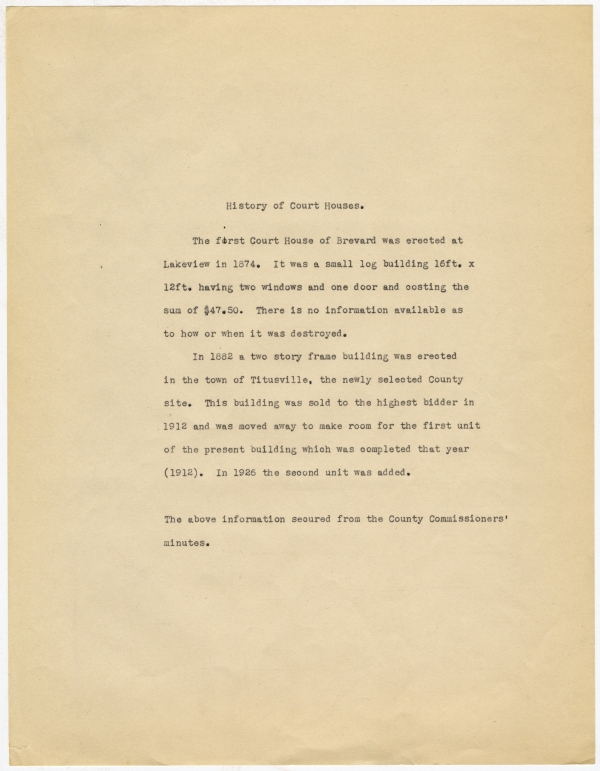


 Listen: The World Program
Listen: The World Program